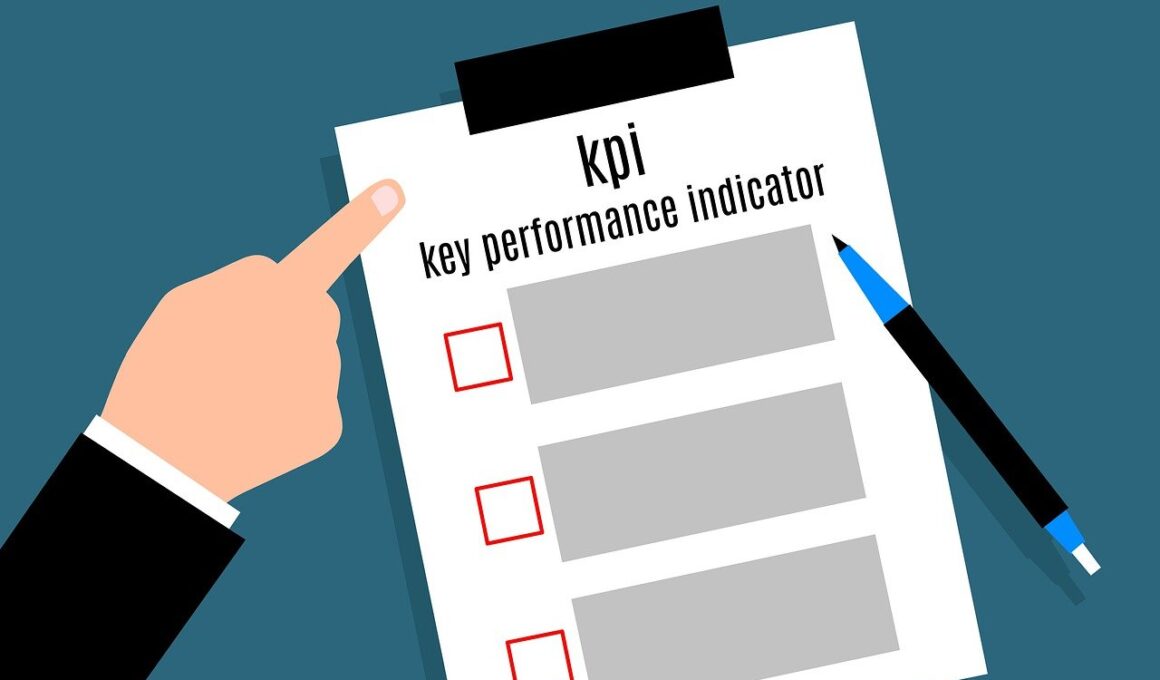How to Adapt Performance Goals in a Changing Business Environment
In today’s fast-paced business landscape, adapting performance goals is crucial for success. Companies must continuously evolve to meet the demands of a rapidly changing market. Establishing flexible performance goals allows teams to remain agile while addressing unforeseen challenges. It’s essential to incorporate metrics that reflect current achievements and align with emerging business strategies. Leaders should regularly assess these objectives to ensure they are relevant and attainable. Involving employees in the goal-setting process not only fosters a sense of ownership but also encourages collaboration across departments. Effective communication plays an integral role in this adaptation. Regular updates and feedback can help teams refocus their efforts and maintain motivation. Companies that leverage data analytics can gain valuable insights into employee performance. This information aids in refining goals to better match market volatility. Additionally, it’s important to recognize and celebrate small wins along the way. This acknowledgment boosts morale and reinforces commitment to overall objectives. In summary, flexibility and involvement are key elements in adapting performance goals effectively during unpredictable times.
Organizations must prioritize aligning performance goals with strategic initiatives to thrive. Setting clear objectives that support the broader vision helps create a cohesive working environment. These ambitious targets should encourage cross-functional collaboration, allowing team members to contribute their unique skills towards shared goals. The use of technology tools can greatly improve tracking progress and provide real-time updates. Various platforms enable visibility into which initiatives are achieving desired outcomes. Moreover, it is vital to prioritize goals that reflect customer needs. Understanding the changing needs of clients can lead to the development of agile strategies that enhance customer satisfaction and loyalty. Effective goal-setting practices should factor in the impact of external influences, such as economic shifts or industry trends. Conducting SWOT analysis can assist management in identifying potential challenges and opportunities. This proactive approach leads to more robust performance goals. Establishing timelines is equally crucial. Deadlines encourage accountability and help teams stay focused. Regularly reviewing and adjusting these goals ensures that they remain relevant and attainable amid shifting landscapes. Ultimately, aligning performance goals with the evolving business climate requires continuous monitoring and willingness to pivot as necessary.
Furthermore, integrating employee feedback into goal adjustment processes can yield significant benefits. Soliciting input from team members helps identify which areas need improvement. Employees on the front lines often have insights that can lead to more effective goals. This approach fosters a culture of transparency and encourages open communication. Organizations should conduct regular check-ins or surveys to gauge employee sentiments regarding performance expectations. The feedback gathered can provide valuable data for leadership. Additionally, clarifying the purpose behind each goal ensures everyone understands its importance within the larger context. Motivation can wane if employees are unsure why certain objectives exist. It’s essential to outline how achieving these goals contributes to both individual and organizational success. Support structures should also be implemented to assist employees in reaching their targets. This can include professional development opportunities, mentorship programs, or resource allocation for their roles. By equipping teams with the necessary tools and training, organizations empower them to strive for excellence. Thus, seamless adaptation of performance goals thrives in an environment where engagement and support are prioritized consistently.
The Importance of Monitoring Performance Goals
Keeping track of performance goals is essential to ensure they are met effectively. Continuous monitoring allows management to identify bottlenecks and areas for improvement. Setting key performance indicators (KPIs) provides measurable benchmarks to assess progress. Regular review meetings can enhance accountability and create a forum for sharing insights. Involving multiple stakeholders ensures diverse perspectives are considered when discussing performance. If any goals are not being met, it’s critical to analyze the underlying reasons. Addressing obstacles early on can prevent issues from escalating. This agility helps maintain momentum within teams. Moreover, recognizing employees’ achievements based on their performance fosters an atmosphere of appreciation. Regularly acknowledging accomplishments motivates individuals and reinforces commitment toward achieving organizational goals. Employing visual tools, like dashboards, can help track progress in an engaging manner. These tools provide snapshots of performance metrics at a glance. They enable teams to visualize their contributions and understand their role in overall business success. Ultimately, monitoring performance goals should be a dynamic process—one that adapts to the ebb and flow of business challenges and opportunities.
Moreover, managers must remain mindful of the emotional aspects tied to performance goals. Setting overly ambitious targets can lead to employee burnout or dissatisfaction. It is essential to strike a balance between challenge and achievability. Incorporating the concept of SMART goals is advisable. These goals are specific, measurable, achievable, relevant, and time-bound. Utilizing this framework can enhance the likelihood of success by providing clear guidelines for performance expectations. Active discussions about the feasibility of goals help maintain realistic objectives. Teams should feel empowered to voice concerns about overly demanding targets. Organizations that prioritize mental well-being will foster more productive environments. Frequent team-building activities can also strengthen connections among coworkers. Emotional support networks may alleviate stress and promote resilience in challenging circumstances. A positive workplace culture supports employees’ long-term engagement with their performance goals. Furthermore, leaders should demonstrate vulnerability by sharing their experiences with setbacks. This authenticity cultivates trust and encourages employees to be more open regarding their challenges. Ultimately, a supportive emotional landscape is conducive to adapting goals as business needs change.
Utilizing Data for Performance Optimization
Leveraging data analytics is critical for optimizing performance goals. Businesses can utilize data-driven insights to streamline processes and enhance individual contributions. By analyzing past performance trends, organizations can identify patterns and predict future outcomes. This information leads to better decision-making and more tailored goal-setting efforts. Data enables teams to focus on what truly matters, thereby elevating overall productivity. Analyzing metrics related to efficiency, customer satisfaction, and other key factors can provide a holistic view of performance levels. Tracking these indicators fosters a culture of continuous improvement. Organizations that embrace technology can remain ahead of the curve amid constant market shifts. Many sophisticated software tools allow for efficient data collection, processing, and visualization. In addition, collaborative platforms enhance data sharing among team members. Greater transparency in how data informs performance discussions leads to accountability and trust. Furthermore, regular training sessions around data literacy ensure that employees understand how to effectively use available tools. Investing in this knowledge ultimately empowers them to contribute valuable insights for setting innovative performance goals tailored to the organization’s needs.
Finally, embracing a culture of learning within the organization promotes adaptability. Companies that prioritize professional development create an environment where employees feel valued and understood. Ongoing training opportunities cater to skill enhancement, preparing teams for new performance objectives. Encouraging cross-training can diversify employees’ competencies and encourage flexibility when fulfilling roles. This adaptability directly impacts how well teams can shift their focus when business priorities change. Periodic workshops can provide insights into effective goal-setting and performance measurement. Engaging expert facilitators may further inspire innovative thinking among employees. Fostering collaboration across various departments encourages knowledge sharing, helping reinforce connections. Moreover, establishing mentoring relationships or peer support systems can guide individuals through changing landscapes. Organizations that invest time in these developmental areas will cultivate resilience among their workforce. This resilient attitude empowers teams to respond positively to shifting performance goals. Ultimately, investing in continuous improvement leads to a more competitive organization, even when faced with adversity. In summary, adapting performance goals effectively involves aligning them with evolving business strategies while maintaining a supportive culture.
In conclusion, adapting performance goals in a changing business environment requires a multifaceted approach. Organizations must remain flexible and agile while ensuring their performance objectives resonate with overall strategy. Regularly reviewing and updating goals fosters a culture of commitment and accountability. Additionally, involving employees in the goal-setting process increases engagement and promotes a sense of ownership among the workforce. Leveraging data analytics further enhances the ability to track progress and measure success accurately. By utilizing technology, organizations can better visualize performance metrics and identify areas for improvement swiftly. Additionally, promoting a positive workplace culture that prioritizes emotional wellbeing leads to higher productivity levels. Ongoing training and professional development initiatives reinforce adaptability among employees, equipping them with necessary skills to meet new challenges. Strong communication channels help ensure that everyone remains aligned with organizational goals, paving the way for success even in turbulent times. Ultimately, embracing a comprehensive strategy for performance goals adaptation enables organizations to thrive in volatile conditions. Encouraging collaboration, transparency, and resilience will foster a workforce committed to achieving excellence and driving company growth.


